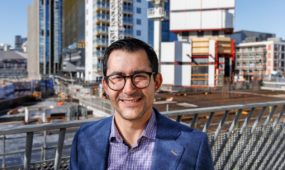Sleep apnoea in children linked to orthodontics
Health & Medical
When Vandana Katyal began studying orthodontics at the University of Adelaide, a paediatrician friend urged her to read more about obstructive sleep apnoea (OSA), her reading led her down a research path she never dreamed of undertaking.

Sign up to receive notifications about new stories in this category.
Thank you for subscribing to story notifications.
“I was shocked by what we know about its impact on young people and by how little research had been done on possible treatments,” she said. “There were lots of studies into adults but no more than a handful of papers on children, even though we’d known children have it for 10 years.”
Since her discovery, she has been part of developing a multi-disciplinary approach to studying paediatric sleep disorders in Adelaide and Sydney.
Katyal’sSleep Disorders Unit at Adelaide’s Women’s and Children’s Hospitalpaediatricians
Their recent published work has focused on craniofacial and upper airway morphology in paediatric sleep-disordered breathing (SDB), an area that to date has been, in their own words, “poorly understood and contradictory”.
The first aim was to evaluate the prevalence of children at-risk for SDB, particularly OSA, and to examine associations with their craniofacial and upper airway morphologies.
In a case-control study, 81 children aged 8-17 were grouped as either high risk or low risk for SDB based on the scores from a validated 22-item Paediatric Sleep Questionnaire and the Obstructive Sleep Apnoea-18 Quality of Life Questionnaire.
Results showed the frequency of palatal crossbite involving at least three teeth (thus suggesting a transversely narrow maxilla) was 68.2% in the high-risk group, compared with just 23.2% for the low-risk group.
Average quality of life scores in the high-risk group indicated reduced quality of life related to sleep-disordered breathing by 16% compared with children in the low-risk group.
That snoring and SDB are strongly linked to a narrow palate is an important finding but one Dr Katyal acknowledges “seems obvious when you think about it”.
“I’m not sure why this has not really been looked at before,” she said. “It might be because most research to date has been retrospective and based around the use of X-rays, which only show two dimensions – the vertical and the anterior/posterior.
“Our work is prospective, studying children in a clinical setting, and this has allowed us to take account of the transverse dimension, where we have found an even greater correlation.
“A lot more work is still needed, but this is an important step up the ladder.”
So, too, were the results from the second phase of the study, which was designed to assess the change in quality of life for affected children undergoing rapid maxillary expansion (RME) to correct a palatal crossbite or widen a narrow maxilla.
Ten children from the study group who underwent RME were followed longitudinally until the appliance was removed about nine months later. Children in the high-risk group showed an average 14% improvement in quality of life compared with those in the low-risk group.
Again this is just another step up the ladder, but it raises hope that an orthodontic approach may be an alternative to surgery for children with a narrow palate. Preliminary results from subsequent research in Sydney and Italy add weight to this proposition.
“While removing the tonsils is the first line of treatment for children with OSA, up to half of those who have their tonsils out continue to suffer,” Dr Katyal said. “Exploring RMEs first in appropriate malocclusions could be a valuable option.”
She cautions, however, that it is too early to claim RMEs could be “a cure” and that orthodontists have to be wary of overstating its value until more research has been completed.
Dr Katyal said while the robust nature of the Adelaide team’s research was one of its strengths it had also created the main complications.
“It was easy to enrol people and easy to get ethics approval because our research was not invasive. The hardest part was keeping all the records and keep everything on track,” she said. “Children don’t always co-operate and we had to keep bringing them back in to see us, which can be quite draining for them.”
The research sample was primarily orthodontic patients who were referred by their local school dentists. Orthodontic data and sleep screening questionnaires were collected over a year, the 10 children who had RME were followed for an additional nine months.
Dr Katyal says an important priority is to raise awareness among the medical and dental communities and the broader population.
Estimates are that 10-12% of Australian children have either chronic snoring or sleep apnoea, she says, with some research suggesting it is as high as 25%,
The message for parents is that snoring is not normal for children, unless they have a cold or some other influences are at play, so if their children snore regularly – more than three times a week – this may be an indication of OSA.
“They need to speak up,” she said. “Research shows that 80% of kids with these problems aren’t diagnosed or reported.”
The message for doctors, dentists and orthodontists is that they are on the front line and have an obligation to do a thorough assessment if they have any reason to believe that young patients may be suffering from SDB.
She believes the aim should be to screen every child who shows signs of air obstruction, with a view to insuring that each child is assessed and treated individually.
“What we really need is to develop a protocol – a consensus on what to do first and who should do it,” Dr Katyal said.
Photos courtesy of Richard Birch, Bite magazine.
Jump to next article



